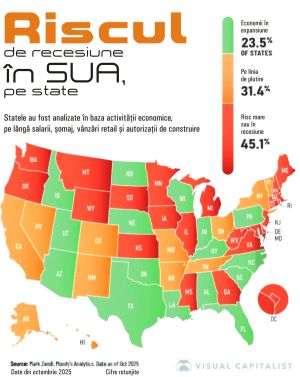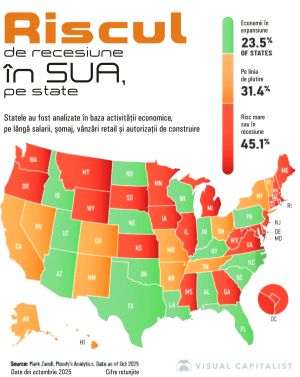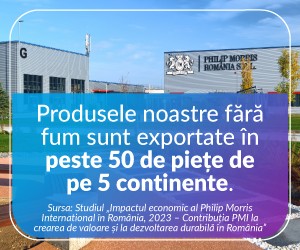Global supply chains, the central pillar of the modern world economy, are on the verge of a deep crisis, fueled by the new tariffs imposed by the Trump administration on imports from China, according to a series of articles published by ZeroHedgeg, CNBC, gcaptain.com, that is, by the American press. The tariff measures announced during April 2025 by President Donald Trump have triggered a chain reaction of proportions, with a severe impact on maritime transport, port activity, trade flows and the entire global logistics structure. According to an article published on gcaptain.com, container transport between the world's two largest economies is being disrupted to an unprecedented level.
The cited sources show that Ryan Peterson, founder and CEO of Flexport, stated that bookings for sea containers from China to the US have fallen by more than 60% in just three weeks since the tariffs came into effect on April 9. Shipping expert John McCown pointed out that in March, China accounted for about 40% of containers entering the US. The real impact of the tariffs imposed by Donald Trump is expected to be felt in ports on the US West Coast in May and on the East Coast and Gulf Coasts in June, due to the time required for transportation from ports of origin, the article published in gcaptain.com shows.
The situation is expected to worsen in the context of a new measure announced for October, which will introduce additional taxes on ships operated by Chinese companies or built in China. McCown characterized this period as the "most difficult" in the history of container shipping, with macro-trends that are deeply destabilizing the sector.
• Big problems for retailers
The cited source shows that the immediate response of the industry was drastic: 81 transpacific voyages were canceled in April alone - a number higher than the 51 cancellations at the peak of the pandemic. Cargo from Asia to the West Coast has fallen by 28% and to the East Coast by 42%. Hapag-Lloyd reported that 30% of shipments from China to the US have already been cancelled, while demand for alternative routes such as Thailand, Cambodia and Vietnam has increased significantly.
In this context, the National Retail Federation (NRF) in the US has revised its import estimates sharply downwards, after 19 consecutive months of growth. Volume in May 2025 is expected to fall by 20.5% compared to last year, and in June the decline could reach 26.6%. For the first half of the year, a total of 11.73 million TEU is expected, marking an annual decrease of 2.9%, in contrast to the previous forecast of 5.7% growth.
According to the cited source, Ryan Peterson warns of serious economic risks, pointing out that the US imports goods worth $600 billion from China annually, 95% of which are transported by sea. The American expert claims that these products are sold on the American market for about $2,000 billion and that a drastic reduction in cargo volume could lead to major shortages this summer.
Craig Fuller, founder of FreightWaves, warns that the "back to school" season is in danger, as related products are shipped during this period. He anticipates the first major shortages in August, warning consumers to prepare in advance.
If Trump were to suddenly eliminate the new tariffs applied to China, we could witness a possible "bullwhip effect", in which massive demand would exceed the industry's ability to react, Ryan Peterson also claims. The redirection of ships to other routes and the recent massive cancellations could prevent the normal resumption of trade flows. In such a scenario, shipping prices could explode again, approaching the levels of 2021-2022, when rates reached almost $20,000 per container.
The cited source mentions that the air transport sector will not be spared either, as moving just 1% of seaborne volume to air transport would be enough to bring prices back to over $10/kg, just like during the pandemic.
This crisis is considered by many to be the most serious threat the shipping sector has ever faced, with implications that go beyond the scope of US-China trade and affect shipping routes globally. Craig Fuller summed up the situation this way: "The economy has COVID, only this time there are no PPPs or incentives. The only solution is to de-escalate tariffs."
Maritime expert John McCown has stressed the importance of a steady pace in supply chain efficiency, noting that any disruption to this balance adds costs and inefficiencies. He concludes that, for now, the effects are uncertain, both in terms of container volume, as well as the potential for inflation.
Although Trump has mentioned the possibility of reducing tariffs from the current level of 145%, industry leaders are calling for quick action to avoid a major crisis. "There is still time to avoid a crisis, but the clock is ticking," Fuller wrote.
• Number of cargo shipping cancellations increases
According to an analysis published by CNBC in the State of Freight section, the impact on American consumers from the new customs tariffs imposed by the Trump Administration will come in stages, with the first signs already visible in supply chains. The quoted source states that despite the fact that large companies such as Walmart, Home Depot and IKEA continue to import in considerable volumes from China, the sharp decline in production orders and the significant reduction in the number of cargo vessels leaving Asia for the US suggest increasing pressure on inventories. While it's not certain that shelves will remain empty, logistics and retail executives warn that low-margin, price-sensitive products like toys, low-cost clothing, and budget home goods will be the first to be hit.
According to Steve Lamar, president of the American Apparel and Footwear Association, the new U.S. tariffs effectively act as a ban on imports, CNBC reports. In 2024, China supplied about 37% of all U.S. apparel imports and about 58% of footwear. With an average tariff of 18.5%, sometimes topped up with additional duties that can push the total cost over 200%, American companies have had little time to find alternative sources of supply. Many orders have already been canceled, and goods are stuck in warehouses awaiting a trade deal.
CNBC reports that shipping industry data shows a sharp decline in orders and an alarming increase in canceled sailings (so-called blank sailings), especially on the Asia-East Coast routes. Alan Murphy, CEO of Sea-Intelligence, warns that many cancellations have been made shortly before departure, signaling a collapse in shipping activity.
That's why the coming period is crucial for retailers. Michael Salerno, vice president of FNBO, told the source that May, June and July will provide decisive clues about the health of the supply chain, depending on the volume of containers and the length of their stay in ports. Casey Armstrong, chief marketing officer of ShipBob, emphasized to CNBC that the American retail system, built on efficiency and speed, is extremely vulnerable to tariff shocks. The products with the highest turnover and lowest margins will disappear first - toys, games, seasonal items, cheap clothes and budget electronics, because even if not all of them are finally assembled in China, their components often come from the Asian country.
Even large retailers that consolidated their inventories at the beginning of the year to avoid the tariff shock - such as Amazon, Walmart and IKEA - are now starting to reduce orders, according to data from SONAR and Import Genius, cited by CNBC. Small businesses, dropshippers and merchants that relied on the de minimis tax exemption for imports from China are also expected to be affected immediately, especially after this loophole closes starting on May 2.
Jonathan Gold, vice president of the National Retail Federation, confirmed to the cited source that inventories have remained high as a result of a frontloading strategy (anticipated imports), but warns that cargo volumes will decrease noticeably in the coming months, and consumers will feel the effects: fewer options, less stock and higher prices, especially in niche trade.
• American experts: The global supply system is approaching a deep crisis
But the problem is not isolated to the US-China conflict. An article published by Zerohedge reveals an even more alarming global picture: the supply chain crisis is aggravated by port blockages, semiconductor shortages, energy crises and geopolitical instability. The cited source states that an eloquent example comes from the auto industry, where Nissan Motor, Japan's third-largest automaker, recently announced an estimated annual loss of between $4.91 billion and $5.26 billion for the fiscal year ending March 2025. Supply chain problems, particularly in semiconductors, have forced the company to reduce production and close plants. In an attempt to save what can still be saved, Nissan has initiated a painful restructuring, marked by layoffs and capacity reductions. These measures reflect the critical state of a sector where the lack of essential parts has blocked assembly lines. As a result, Nissan shares have suffered a sharp decline, dragging down other auto companies in the industry.
According to Zerohedge, CEOs of large companies are scrambling behind the scenes to redirect supply chains, but solutions are few and far between. Trade wars are intensifying, while states are closing their economic borders and resorting to export bans to preserve their strategic resources. These measures, although apparently protective, are further strangling global trade. Analysts are sounding the alarm, warning that this crisis could mark the beginning of a "lost decade" in terms of global economic growth.
To assess the seriousness of the situation in real time, the specialists of the cited source have turned to indicators such as the Outbound Tender Volume Index (OTVI), developed by Freight Waves SONAR. This index measures the volume of electronic transport requests (e-tenders) from shippers to U.S. road carriers and provides a clear picture of transport demand and the health of supply chains. According to specialists, the recent data is worrying and confirms what many still refuse to accept: the global supply system is approaching a deep crisis.
• Companies, constantly surprised by supply chain disruptions
Financial expert Duane Kotsen, Partner at Marlborough Street Partners, states in an article published on Linkedin that the trade tariffs imposed by the Trump Administration are a new existential threat to global supply chains. Tariff wars between major powers, bans on sensitive technology, economic retaliation, factory relocations - all create the impression of a turning point, an unprecedented shock, argues the financial expert, who shows that, however, the reality is that tariffs are far from a singular event, but just the next chapter in a decades-long story, in which disruptions have become a constant.
Analyzing what has happened in recent decades, Duane Kotsen shows that it is clear that global supply chains have been shaped not only by economic progress, but also by numerous events that have tested their fragility. Since the post-war years, with the Bretton Woods system, globalization has redefined the way economies collaborate, increased the interdependence of states and led to a spectacular reduction in extreme poverty - from 60-70% in the 1940s to under 10% today. However, the cited financial expert states that this interconnection has also brought structural vulnerability, demonstrated by the dramatic increase in the frequency of major disruptions over the past 30 years, with supply chains being shaken by deep crises such as the 2008 global financial crisis, the Fukushima disaster, the US-China trade war, the COVID-19 pandemic, the Suez Canal blockade, the Ukraine conflict and the recent disruptions in the Red Sea. The cited source mentions that each of these events has demonstrated in different ways how fragile the system is: either by collapsing demand, by completely interrupting logistics flows, or by displacing essential suppliers. And each time, companies have been taken by surprise, promising to prepare better next time, only to repeat the mistakes in the next crisis.
Duane Kotsen mentions that behind these events lie deep structural transformations. Globalization has not only meant more trade, but also increasing complexity. The parts of a single product are manufactured and assembled in different corners of the world, and the increase in the volume of international trade, the number of multinational companies and the dependence on cross-border supply chains has led to a highly efficient but equally exposed system. The world is no longer governed by a single pole of economic or political power, and geopolitical fragmentation encourages protectionism and national policies to the detriment of global stability. The Just-In-Time model, once praised for its efficiency, has become a source of fragility, as it has removed any form of buffer in the event of an unforeseen disruption. In addition, climate crises and natural disasters are more frequent and severe, and digitalization, while offering visibility and automation, has introduced new types of vulnerabilities, such as cyberattacks and dependence on complex IT systems. All this makes resilience not a theoretical concept, but a vital necessity. It's no longer enough to react to the next crisis, you need to be prepared for it before it happens. This means a profound rethinking of how companies design their supply chains. It's no longer just about maximum efficiency, but about the ability to continue operating despite disruptions. Companies that do this are not those that avoided the last crisis, but those that have built a system capable of withstanding and adapting quickly. Diversifying sources, investing in visibility along the entire chain, simulating risk scenarios, accepting forms of redundancy as part of the strategy and automating logistics decisions are elements that can make the difference between collapse and continuity, says the quoted financial expert.
In a climate marked by economic uncertainty and growing trade tensions, it is clear that the extension of the current tariff conflict will bring direct and visible costs not only for the American consumer, but also for the entire world. It remains to be seen whether the US and China will resume trade negotiations in the near future. Until then, empty shelves will become a visible indicator of the global fragility of supply chains.
Faced with this gloomy landscape, a fundamental question arises: will the markets manage to adapt to the new reality or will this crisis be the turning point that will rewrite the rules of the global economy for future generations?























































